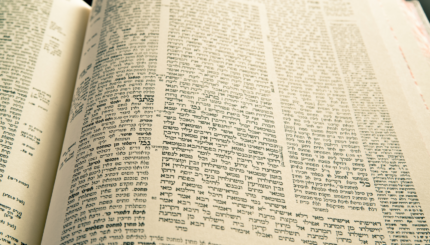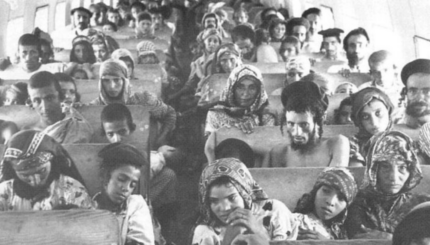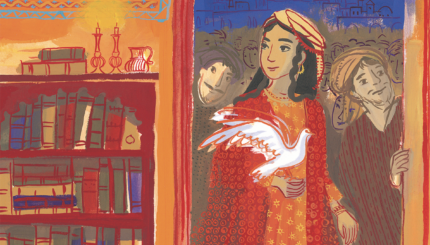For millennia, it has been taken for granted that the place for Jewish women was in the home and in the kitchen. And of all the public arenas that women were discouraged from entering, the Beit Midrash (study hall) was on the top of the list. Many Jewish women never even had the opportunity to engage with a page of .
While that reality has changed for most modern Jewish women, we owe a great debt to those pioneers who cleared the way for thousands of Jewish women to engage in high level and Talmud study.
To celebrate a few of these women, JOFA has teamed up with six young Jewish women artists to create a poster featuring six such educational leaders from the 19th and 20th centuries. These posters are available now through a Kickstarter campaign ending July 14.
Meet the scholars:
Nechama Leibowitz (1905-1997) Nechama Leibowitz was born in 1905 in Riga, educated in Berlin, and moved to Palestine in 1930. She taught at many schools including Tel Aviv University, where she was appointed a full professor. In 1942, she began distributing stenciled pages of questions on the weekly Torah portion, They reached a vast audience and were eventually translated and published. She was awarded the Israel Prize for Education. Though her thoughtful, literary approach to the Bible revolutionized Torah study, she humbly insisted, “I only teach what the commentaries say. Nothing is my own.” Her tombstone is inscribed, “Nechama Leibowitz: teacher.”
After graduating high school in Baltimore, Henrietta Szold established the first American night school to teach English and vocational skills to Jewish immigrants in Baltimore. After moving to New York, she became an editor for the Jewish Publication Society. At the age of 49, her first trip to Palestine sealed her life’s mission: the health, education, and welfare of the Yishuv. In 1912 she founded Hadassah, which became the largest and most powerful Zionist organization in America, and which now boasts 330,000 members worldwide. Starting in 1933, Szold also ran Youth Aliyah, which helped save 30,000 children from Nazi death camps.
Rachel “Ray” Frank was born in San Francisco to Polish immigrant parents at a time when Jewish communities were just beginning to emerge in the West. She taught bible studies and Jewish history in California, where she quickly garnered a large following. She rose to prominence after delivering a series of sermons in Washington for the High Holidays and was soon dubbed “the Jewess in the Pulpit,” and later, “the Golden Girl Rabbi of the West.” Although she had no rabbinic aspirations, Ray Frank’s presence in the pulpit made space in the collective imagination for public female religious leadership.
Farha “Flora” Sassoon was born in Bombay to a family of influential tradesmen from Baghdad known as the “Rothschilds of the East.” By the age of seventeen, she knew Hebrew, Aramaic, Hindustani, English, French, German and had a thorough knowledge of Jewish texts. She wrote on Rashi, lectured on religious education, read publicly from the Torah, and her expertise in doctrine and practice was unparalleled. According to historian Cecil Roth, she “walked like a queen, talked like a sage and entertained like an Oriental potentate.”
Born in Poland, Beilka “Bessie” Gotsfeld immigrated to New York with her family in 1905. In 1925, she founded the precursor of AMIT, an organization connecting religious women to the cause of Zionism and expanding educational and vocational opportunities for religious women in Israel. Gotsfeld became the Palestine representative of the organization, eventually settling in Tel Aviv. She worked to establish three urban vocational schools for adolescent girls and two large farm villages that provided Jewish children, Holocaust survivors, and new immigrants educational programs and resources.
Born in Krakow to poor Hassidic parents, Sarah Schenirer left school after she turned thirteen and became a seamstress. After World War I broke out, she started to teach Jewish studies to a group of girls. This blossomed into 300 schools now known as the “Beis ” network, and by the time of her death approximately 35,000 girls were learning at Beis Yaakov schools. In her will, she wrote: “My dear girls, you are going out into the great world. Your task is to plant the holy seed in the souls of pure children. In a sense, the destiny of Israel of old is in your hands.”
Get your copy of the Sukkot poster before the Kickstarter campaign ends on July 14.
Sukkot
Pronounced: sue-KOTE, or SOOH-kuss (oo as in book), Origin: Hebrew, a harvest festival in which Jews eat inside temporary huts, falls in the Jewish month of Tishrei, which usually coincides with September or October.



